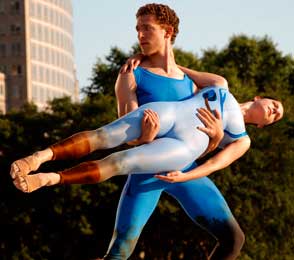
Merce Cunningham, Event, 2009. Performance views, Rockefeller Park, New York. Presented by River to River Festival and Joyce Theater. August 1–2, 2009. Dylan Crossman, Daniel Madoff, Andrea Weber, Silas Riener, and Brandon Collwes. (All photos: Ryan McNamara)
ON AUGUST 1 AND 2, less than a week after Merce Cunningham’s death, members of his company gathered in Lower Manhattan to perform their first scheduled piece since his passing: the last, presumably, of the legendary site-specific Events to have been overseen by the choreographer. Over the course of those two days, in a small wedge of park between the gleaming postmillennium luxury condominiums (with names like the Solaire, the Riverhouse, and—perhaps appropriately—Tribeca Pointe) and the glistening waters of the Hudson, more than a thousand people sat in the grass around two small stages—one farther northeast, the other closer to the river—to partake in what had become, by default, an impromptu Cunningham memorial.
A number of former Cunningham disciples—many now major choreographers in their own right—were present for Saturday evening’s performance, given under an appropriately estival clear blue sky. Yvonne Rainer had staked out a space in the grass between the two stages, while Steve Paxton sat a bit north. Karole Armitage was there, as was the artist Charles Atlas, who got his start as Cunningham’s videographer. Younger choreographers, such as Sarah Michelson, Jack Ferver, and Jonah Bokaer (also a former Cunningham dancer, and the founder of the dance space Chez Bushwick), came to pay homage over the course of the two nights (a third performance in between the two had to be canceled due to the rain), as did art dealers Carol Greene and Janice Guy, artists Vera Lutter and Matthew Buckingham, and the art historian Douglas Crimp.
The dancers performed on both platforms, moving in between the two via a long path cordoned off in the grass. It was impossible to see everything; the split stages (with the northeast devoted more to solos and the southwest largely to ensembles) thwarted scopophilia, just as the multidirectional dancing destabilized any illusions of omniscient viewing. If dance is already an ephemeral medium, the dismantling of traditional sight lines makes it infinitely more so. “The Cunningham challenge,” as Lutter sagely put it.
The Event rose to the occasion; could it have been any other way? “Indescribable,” Paxton accurately described it. The characteristic Cunningham tics—if such a relentless innovator could be said to have any—were prevalent: the isolated, often incongruous choreography for different bodies (or even different parts of the same body); the unexpected shifts in style and tempo, executed according to a logic known only to the dancers; the swift, stage-consuming lateral movements. There’s a great deal of running—or an approximation of running, quick and utilitarian, often with arms slightly raised but parallel to the body (sometimes, to me, evoking action figures). There are frequent moments in relevé, and though the dancers are always extraordinarily composed and purposeful, strain is never obscured. Cunningham’s style influenced everyone, but here was evidence that the style itself remains inimitable. (Much of this may have to do with his dancers; he left behind an incredible company—perhaps the best in the world.)
Because of the fleetingness of it all, I found myself clinging to certain phrases harder than usual. (A favorite, which I remembered from the final Beacon Event in May, featured Andrea Weber in demi-pointe, with one hand extended above and one below; she held it for an excruciating amount of time, until Brandon Collwes, the tattooed perfectionist, arrived at her side to relieve her, beginning their own intimate partnering.) Sitting up close, just a few feet from the stages, it was impossible not to fall under the sway of individual dancers; everyone’s a soloist, each one impossibly gifted. When Weber isn’t smiling it looks as though she is, and when she is she’s practically beaming; the chiseled Silas Riener often has a stoic, faraway look, and at least once Weber patted him as she left the stage, as if to console him.
Roughly two-thirds of the way through the Event, the dancers paused to perform the three “still” movements of 4'33", which Cunningham planned as a memorial to John Cage but which became an uncanny tribute to Cunningham as well. The choreography was indeterminate, which meant the dancers could choose any pose they liked—Riener said that he had known only that he simply wanted to “face the water”—and at the end of the final movement, as dancers took to the warm-up area adjacent to the stage, many were crying.
According to Calvin Tomkins’s 1968 New Yorker profile on Cunningham, Alice B. Toklas had approached the choreographer after a 1949 recital and told him she liked his dancing “because it’s so pagan.” This comment came to mind while watching the movement on the westernmost stage, which at times did seem to exude a peculiar jocularity, featuring numerous ritualistic and presentational gestures. Near the end of the performance, on that same stage, Weber, Emma Desjardins, and Marcie Munnerlyn performed a mesmerizing adagio trio, which was followed by three male dancers—Riener, Collwes, and the new Dylan Crossman (one of two fresh-faced but exceptional dancers who joined the company a mere two weeks ago)—who leaped around variously like mantises, their arms curving inward, or exuberant cranes, arms extended. The dance ended, as Crimp noted, with the same, climactic sequence that marked the conclusion to the fourth Beacon Event, with all eleven dancers—eight on one stage, three on the other—dancing in unison. (“A finale worthy of Petipa or Balanchine,” he wrote last year.)
On Sunday, the loss seemed doubly painful; there would never be another new Cunningham Event. Seated on a platform to the east, next to Cunningham’s longtime archivist David Vaughan, was Alastair Macaulay, the Times’s chief dance critic, in tears. “Bravo,” he mouthed. Bravo. The dancers filed solemnly out of the park, and the crowd dispersed in the gloaming. |
